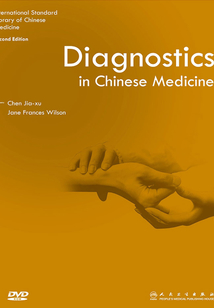最新章節
- Section 2 Analysis of Cases
- Section 1 Diagnosis Methods Training
- Chapter 15 Diagnosis Methods Training and Case Analysis
- Example of how to write an outpatient medical record
- Chapter 14 Examples of Traditional Chinese Medical Records
- Conclusion
品牌:人衛社
上架時間:2022-04-24 09:58:32
出版社:人民衛生出版社
本書數字版權由人衛社提供,并由其授權上海閱文信息技術有限公司制作發行
- Section 2 Analysis of Cases 更新時間:2022-04-24 10:29:54
- Section 1 Diagnosis Methods Training
- Chapter 15 Diagnosis Methods Training and Case Analysis
- Example of how to write an outpatient medical record
- Chapter 14 Examples of Traditional Chinese Medical Records
- Conclusion
- Storage Access and Retrieval
- Outcome Measures Action and Advice
- Point Prescription or Herbal Prescription
- Treatment Plan
- Treatment Principle and Strategy
- Diagnosis Interpretation and Analysis
- Signs Symptoms and Etiologies
- Principles and Priorities for Recording a Case Record
- Chapter 13 The Case Record
- Section 4 Pattern Differentiation According to the Twelve Channels
- Section 3 Pattern Differentiation According to the Sanjiao Theory
- Section 2 Pattern Differentiation According to the Wei Qi Ying and Blood
- Section 1 Pattern Differentiation According to the Six Channels/Stages
- Chapter 12 Additional Patterns Differentiation
- Section 6 Combined Patterns of Zang-fu Organs
- Section 5 Kidney and Bladder Pattern Differentiation
- Section 4 Liver and Gallbladder Pattern Differentiation
- Section 3 Spleen and Stomach Pattern Differentiation
- Section 2 Lung and Large Intestine Pattern Differentiation
- Section 1 Heart and Small Intestine Pattern Differentiation
- Chapter 11 Differentiation of Patterns According to the Zang-Fu Organs
- Section 4 Patterns of Body Fluids
- Section 3 Simultaneous Qi and Blood Disease Pattern Identification
- Section 2 Patterns of Blood
- Section 1 Patterns of Qi
- Chapter 10 Pattern Differentiation According to Qi Blood and Body Fluids
- Section 4 External Injury or Trauma (Table 9-9)
- Section 3 Pattern Differentiation of Diseases due to Improper Diet Overstrain or Lack of Exercise (Table 9-8)
- Section 2 Pattern Identification of the Seven Emotions
- Section 1 Pattern Identification of the Six Exogenous Pathogenic Factors
- Chapter 9 Differentiation of Patterns According to Pathogenic Factors
- Section 3 The Relationship Among the Eight Principles Patterns
- Section 2 The Basic Patterns of the Eight Principles
- Section 1 Concept of Pattern Differentiation According to the Eight Principles
- Chapter 8 Pattern Differentiation According to the Eight Principles
- Section 2 Areas for Palpatory Examination
- Section 1 Contents of the Palpatory Examination Including Methods and Significance
- Contents of the palpating examination
- Chapter 7 Palpatory Examination
- Section 5 Clinical Application and Significance of the Pulse Examination
- Section 4 Examination of the Pulses of Women and Children
- Section 3 Abnormal Pulse Images
- Section 2 A Healthy Pulse Image
- Section 1 Overview of the Pulse Examination
- Contents of the pulse examination
- Chapter 6 Pulse Examination
- Section 3 Present illness history
- Section 2 Contents of the Inquiry Examination
- Section 1 Significance and Method of the Inquiry Examination
- Contents of the inquiry examination
- Chapter 5 Inquiry Examination
- Section 2 Smelling Odours
- Section 1 Listening to Sounds
- Contents of the listening and smelling examination
- Chapter 4 Listening and Smelling Examination
- Section 5 Clinical Significance of the Tongue Examination
- Section 4 Main Points for Analysing the Tongue Manifestations
- Section 3 Contents of the Tongue Examination
- Section 2 Normal Tongue Manifestation and Physiological Differences
- Section 1 Overview of the Tongue Examination
- Contents of the Tongue Examination
- Chapter 3 Tongue Examination
- Section 4 Inspection of the Superficial Vein of the Index Finger
- Section 3 Inspection of Excreta
- Section 2 Inspection of the Circumstances of Various Parts of the Body
- Section 1 Inspection of the Circumstances of the Entire Body
- Contents of the Inspection Examination
- Chapter 2 Inspection Examination
- 3. A Brief History of Development of Diagnosis of CM
- 2. The Basic Principles in Diagnosis of CM
- 1. The Main Contents of Chinese Medical Diagnosis
- Chapter 1 Introduction
- Preface
- Editorial Board for International Standard Library of Chinese Medicine of the 1st edition
- About the Authors
- Contributors (Listed alphabetically by name)
- Copyright in English
- Copyright in Chinese
- Cover
- Cover
- Copyright in Chinese
- Copyright in English
- Contributors (Listed alphabetically by name)
- About the Authors
- Editorial Board for International Standard Library of Chinese Medicine of the 1st edition
- Preface
- Chapter 1 Introduction
- 1. The Main Contents of Chinese Medical Diagnosis
- 2. The Basic Principles in Diagnosis of CM
- 3. A Brief History of Development of Diagnosis of CM
- Chapter 2 Inspection Examination
- Contents of the Inspection Examination
- Section 1 Inspection of the Circumstances of the Entire Body
- Section 2 Inspection of the Circumstances of Various Parts of the Body
- Section 3 Inspection of Excreta
- Section 4 Inspection of the Superficial Vein of the Index Finger
- Chapter 3 Tongue Examination
- Contents of the Tongue Examination
- Section 1 Overview of the Tongue Examination
- Section 2 Normal Tongue Manifestation and Physiological Differences
- Section 3 Contents of the Tongue Examination
- Section 4 Main Points for Analysing the Tongue Manifestations
- Section 5 Clinical Significance of the Tongue Examination
- Chapter 4 Listening and Smelling Examination
- Contents of the listening and smelling examination
- Section 1 Listening to Sounds
- Section 2 Smelling Odours
- Chapter 5 Inquiry Examination
- Contents of the inquiry examination
- Section 1 Significance and Method of the Inquiry Examination
- Section 2 Contents of the Inquiry Examination
- Section 3 Present illness history
- Chapter 6 Pulse Examination
- Contents of the pulse examination
- Section 1 Overview of the Pulse Examination
- Section 2 A Healthy Pulse Image
- Section 3 Abnormal Pulse Images
- Section 4 Examination of the Pulses of Women and Children
- Section 5 Clinical Application and Significance of the Pulse Examination
- Chapter 7 Palpatory Examination
- Contents of the palpating examination
- Section 1 Contents of the Palpatory Examination Including Methods and Significance
- Section 2 Areas for Palpatory Examination
- Chapter 8 Pattern Differentiation According to the Eight Principles
- Section 1 Concept of Pattern Differentiation According to the Eight Principles
- Section 2 The Basic Patterns of the Eight Principles
- Section 3 The Relationship Among the Eight Principles Patterns
- Chapter 9 Differentiation of Patterns According to Pathogenic Factors
- Section 1 Pattern Identification of the Six Exogenous Pathogenic Factors
- Section 2 Pattern Identification of the Seven Emotions
- Section 3 Pattern Differentiation of Diseases due to Improper Diet Overstrain or Lack of Exercise (Table 9-8)
- Section 4 External Injury or Trauma (Table 9-9)
- Chapter 10 Pattern Differentiation According to Qi Blood and Body Fluids
- Section 1 Patterns of Qi
- Section 2 Patterns of Blood
- Section 3 Simultaneous Qi and Blood Disease Pattern Identification
- Section 4 Patterns of Body Fluids
- Chapter 11 Differentiation of Patterns According to the Zang-Fu Organs
- Section 1 Heart and Small Intestine Pattern Differentiation
- Section 2 Lung and Large Intestine Pattern Differentiation
- Section 3 Spleen and Stomach Pattern Differentiation
- Section 4 Liver and Gallbladder Pattern Differentiation
- Section 5 Kidney and Bladder Pattern Differentiation
- Section 6 Combined Patterns of Zang-fu Organs
- Chapter 12 Additional Patterns Differentiation
- Section 1 Pattern Differentiation According to the Six Channels/Stages
- Section 2 Pattern Differentiation According to the Wei Qi Ying and Blood
- Section 3 Pattern Differentiation According to the Sanjiao Theory
- Section 4 Pattern Differentiation According to the Twelve Channels
- Chapter 13 The Case Record
- Principles and Priorities for Recording a Case Record
- Signs Symptoms and Etiologies
- Diagnosis Interpretation and Analysis
- Treatment Principle and Strategy
- Treatment Plan
- Point Prescription or Herbal Prescription
- Outcome Measures Action and Advice
- Storage Access and Retrieval
- Conclusion
- Chapter 14 Examples of Traditional Chinese Medical Records
- Example of how to write an outpatient medical record
- Chapter 15 Diagnosis Methods Training and Case Analysis
- Section 1 Diagnosis Methods Training
- Section 2 Analysis of Cases 更新時間:2022-04-24 10:29:54



